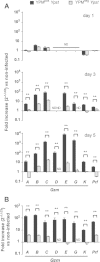Superantigenic Yersinia pseudotuberculosis induces the expression of granzymes and perforin by CD4+ T cells
- PMID: 25754199
- PMCID: PMC4399040
- DOI: 10.1128/IAI.02339-14
Superantigenic Yersinia pseudotuberculosis induces the expression of granzymes and perforin by CD4+ T cells
Abstract
Bacterial superantigens (SAgs) are immunostimulatory toxins that induce acute diseases mainly through the massive release of inflammatory cytokines. Yersinia pseudotuberculosis is the only Gram-negative bacterium known to produce a SAg (Y. pseudotuberculosis-derived mitogen [YPM]). This SAg binds major histocompatibility complex class II molecules on antigen-presenting cells and T cell receptors (TcR) bearing the variable region Vβ3, Vβ9, Vβ13.1, or Vβ13.2 (in humans) and Vβ7 or Vβ8 (in mice). We have previously shown that YPM exacerbates the virulence of Y. pseudotuberculosis in mice. With a view to understanding the mechanism of YPM's toxicity, we compared the immune response in BALB/c mice infected with a YPM-producing Y. pseudotuberculosis or the corresponding isogenic, SAg-deficient mutant. Five days after infection, we observed strong CD4(+) Vβ7(+) T cell expansion and marked interleukin-4 (IL-4) production in mice inoculated with SAg-producing Y. pseudotuberculosis. These phenomena were correlated with the activation of ypm gene transcription in liver and spleen. A transcriptomic analysis revealed that the presence of YPM also increased expression of granzyme and perforin genes in the host's liver and spleen. This expression was attributed to a CD4(+) T cell subset, rather than to natural killer T (NKT) cells that display a TcR with a Vβ region that is potentially recognized by YPM. Increased production of cytotoxic molecules was correlated with hepatotoxicity, as demonstrated by an increase in plasma alanine aminotransferase activity. Our results demonstrate that YPM activates a potentially hepatotoxic CD4(+) T cell population.
Copyright © 2015, American Society for Microbiology. All Rights Reserved.
Figures







Similar articles
-
Continuous exposure of mice to superantigenic toxins induces a high-level protracted expansion and an immunological memory in the toxin-reactive CD4+ T cells.J Immunol. 2002 Apr 15;168(8):3817-24. doi: 10.4049/jimmunol.168.8.3817. J Immunol. 2002. PMID: 11937534
-
Superantigenic properties of a novel mitogenic substance produced by Yersinia pseudotuberculosis isolated from patients manifesting acute and systemic symptoms.J Immunol. 1993 Oct 15;151(8):4407-13. J Immunol. 1993. PMID: 8409410
-
Critical role of T cell migration in bacterial superantigen-mediated shock in mice.Clin Immunol. 2004 Feb;110(2):159-71. doi: 10.1016/j.clim.2003.10.009. Clin Immunol. 2004. PMID: 15003813
-
The superantigenic toxin of Yersinia pseudotuberculosis: a novel virulence factor?Int J Med Microbiol. 2000 Oct;290(4-5):477-82. doi: 10.1016/S1438-4221(00)80069-7. Int J Med Microbiol. 2000. PMID: 11111929 Review.
-
[Viral superantigens].Mikrobiyol Bul. 2016 Jul;50(3):491-504. doi: 10.5578/mb.24250. Mikrobiyol Bul. 2016. PMID: 27525406 Review. Turkish.
Cited by
-
Direct Manipulation of T Lymphocytes by Proteins of Gastrointestinal Bacterial Pathogens.Infect Immun. 2018 Apr 23;86(5):e00683-17. doi: 10.1128/IAI.00683-17. Print 2018 May. Infect Immun. 2018. PMID: 29339462 Free PMC article. Review.
-
Yersinia pseudotuberculosis supports Th17 differentiation and limits de novo regulatory T cell induction by directly interfering with T cell receptor signaling.Cell Mol Life Sci. 2017 Aug;74(15):2839-2850. doi: 10.1007/s00018-017-2516-y. Epub 2017 Apr 4. Cell Mol Life Sci. 2017. PMID: 28378044 Free PMC article.
-
Experimental Nanovaccine Offers Protection Against Repeat Exposures to Trypanosoma cruzi Through Activation of Polyfunctional T Cell Response.Front Immunol. 2020 Dec 22;11:595039. doi: 10.3389/fimmu.2020.595039. eCollection 2020. Front Immunol. 2020. PMID: 33414785 Free PMC article.
-
Aetiological Significance of Infectious Stimuli in Kawasaki Disease.Front Pediatr. 2019 Jun 28;7:244. doi: 10.3389/fped.2019.00244. eCollection 2019. Front Pediatr. 2019. PMID: 31316950 Free PMC article. Review.
-
Yersinia versus host immunity: how a pathogen evades or triggers a protective response.Curr Opin Microbiol. 2016 Feb;29:56-62. doi: 10.1016/j.mib.2015.11.001. Epub 2015 Nov 27. Curr Opin Microbiol. 2016. PMID: 26638030 Free PMC article. Review.
References
Publication types
MeSH terms
Substances
LinkOut - more resources
Full Text Sources
Molecular Biology Databases
Research Materials

